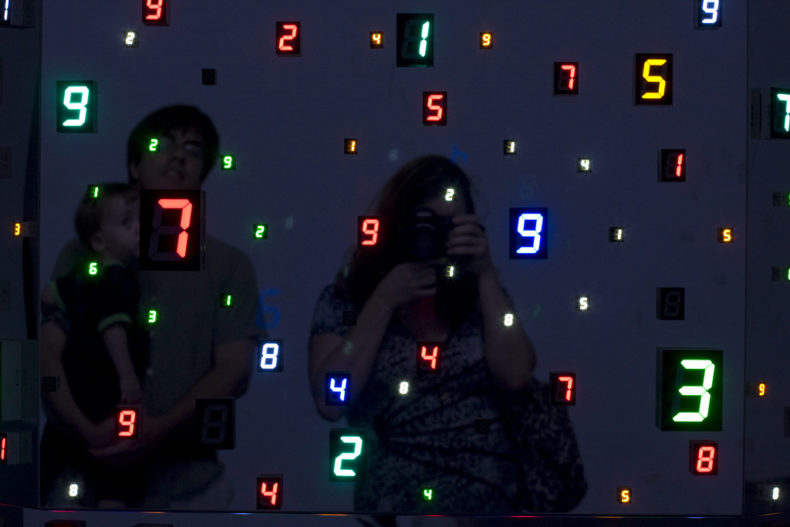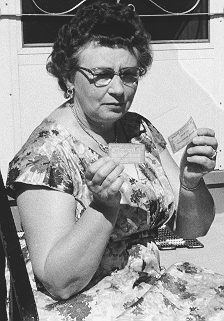
In 1938 a wallet manufacturer called the E.H. Ferree company had a genius idea: to show people just how well cards would fit in the wallet, by using a placeholder. This was before credit cards and before many drivers licenses were small enough to fit into wallets. So the thing they used to showcase the wallet was a social security card. The card they placed in each and every wallet was only about half the size of a real social security card, and that had “specimen” printed in red all over it. The placeholder card was fake in almost all ways but one: The social security number on it was real. It belonged to the secretary of the company’s Vice President and Treasurer, a woman named Mrs. Hilda Schrader Whitcher.
The wallet was sold all over the US in Woolworth stores. And soon after it hit the shelves, people started using that social security number as their own.
According to The Social Security Administration, at the peak of the Whitcher confusion, 5,755 people were using her social security number. In total, they say that over 40,000 people have reported her number as their own. Eventually the Social Security Administration voided the number, and gave poor Mrs. Witcher a new one. But not after the FBI showed up at her house, asking why so many people were using her number.
As long as we’re using numbers and names to link our true selves to our various state issued identities, these kinds of confusions will probably never stop. Sometimes they’re small, hard to avoid mixups. There was a delightful story in the Guardian recently about a woman who thought her identity had been stolen, only to find out that instead she simply had the same name as another woman in the same city.
Other times they’re more careless, like the social security wallet. Perhaps the most famous of these is the Tommy Tutone song “867-5309” which is a working number in plenty lot of area codes. When the song came out in 1981, it was immediately a nightmare for anybody with the number. And some say the calls haven’t stopped since the song was released. In 2004 someone tried to auction the number off on eBay with a New York City area code. The auction was shut down by Verizon, but not before it had reached $80,000.
In 2003, the movie Bruce Almighty flashed a phone number for God. 776-2323. It didn’t give an area code, which meant that movie goers would go home and just add their own. A woman named Dawn Jenkins, a glassmaker living in Florida, told CBS that she was getting 20 calls an hour from people who wanted to speak with God. In San Fransisco, the number rang up an actual church whose pastor was named Bruce, if you can believe it. In the U.K. a man named Andy Green told the BBC he was getting 70 calls a day, and that he was considering suing Universal over it. “I have hardly slept” he said at the time.
As a quick aside: Starting in the 1960’s, TV and movie producers would always use 555 numbers, because they aren’t given out to anybody. Instead, 555 numbers are generally used for internal phone company services. And according to TV Tropes, the numbers 555-0100 through 555-0199 are actually reserved totally for fictional use. Although many producers don’t like to use them, since savvy audience members know the numbers are fake, and it can snap them out of the movie for a moment.
In 1955, a Sears ad printed a phone number which you could call and talk to Santa. The problem was the number didn’t go to Santa, and it didn’t go to anybody who worked at Sears. It actually went to a top secret red phone on the desk of Colonel Harry Shoup. A number that, according to his kids, was only known by four-star generals at the Pentagon and Col. Shoup himself. When the red phone rang, it was a big deal. And then it started ringing off the hook with kids who wanted to talk to Santa. Thankfully, Col. Shoup took it well, and actually turned the phone line into a Christmas favorite: the NORAD Santa tracker.
printed a phone number which you could call and talk to Santa. The problem was the number didn’t go to Santa, and it didn’t go to anybody who worked at Sears. It actually went to a top secret red phone on the desk of Colonel Harry Shoup. A number that, according to his kids, was only known by four-star generals at the Pentagon and Col. Shoup himself. When the red phone rang, it was a big deal. And then it started ringing off the hook with kids who wanted to talk to Santa. Thankfully, Col. Shoup took it well, and actually turned the phone line into a Christmas favorite: the NORAD Santa tracker.
There’s something thrilling about these stories to me. They’re a reminder that this orderly system of names and numbers that we’ve built is really just one slightly misguided decision away from collapsing on us. A reminder that we’re relying on a set of spreadsheets, a series of randomly assigned numbers, to keep us all in order. But that those spreadsheets and numbers can indeed fail us. I’m the only Rose Eveleth in the world, as far as I know, which is great for when I forget to bring business cards. But there’s something appealing about being able to fade into a sea of other John Smiths or Sarah Millers. There’s something enticing about stories that break the illusion that these numbers define us and keep our identities safe and in their individual little boxes.
Then again, if this kind of thing actually happened to me, I’d probably be as annoyed as Mrs. Whitcher, who later would say of the folks using her social security number as their own: “I can’t understand how people can be so stupid. I can’t understand that.”
Numbers Everywhere, photo by Bridget Coila, Flickr.
Mrs. Whitcher with her actual social security card and the fake one from the wallets. Credit: Social Security Administration.
“I can’t understand how people can be so stupid. I can’t understand that.” echoes Charles Babbage; “I am not able rightly to apprehend the kind of confusion of ideas that could provoke such a question.”
and might well turn out to be the most important question there is.